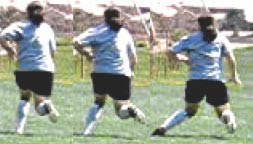During my first affiliation, my clinical instructor and myself had the opportunity to assess an individual 5 days after he had undergone an Anterior Cruciate Ligament (ACL) reconstruction surgery.
5 days? Shouldn’t he still be recovering? What exercises could he do? What should he not do? Should I put my hands on his knee? Why was he coming in to see us so soon?
Luckily, as a student physical therapist, I was not on my own, and I had a great clinical instructor. He picked up on my fear and understood the importance of not allowing that fear to be portrayed to the patient. It was a huge learning point for me, not only because I learned the proper ACL rehabilitation protocol, but I learned the importance of portraying confidence and giving reassurance to the patient.
Since that initial encounter with a patient who had undergone an ACL reconstruction surgery, I have rehabilitated hundreds of patients who had undergone a similar surgery. The reassurance and rehabilitation process has become second nature. There are stages of rehab, and goals that go along with each stage. The progression starts with ensuring quadricep activation and progresses to ensuring optimal neuromuscular control to minimize the risk of re-injury. From a physical therapists point of view, the rehabilitation process is pretty simple and straightforward. I don’t want to belittle the process, but unfortunately rehabbing an individual who has suffered an ACL rupture has become fairly common, and it can therefore be pretty easy as a practitioner to forget about the client. While this may be commonplace in a Physical Therapy clinic, the individuals going through this process are likely going through a challenge completely unlike anything they have ever done before.
Life has a funny way of reminding you why you are doing what you’re doing, and who you are doing it for.
I was watching my beautiful 1 year old daughter, and my wife was behind me apparently doing a bunny hop. 2 milliseconds and a loud pop later and my wife was lying on the ground clutching her knee…
“I’m fine” she said minutes later as she attempted to stand and take a step, only to realize that her knee would not support her. My mind was racing,
Mechanism of injury – Check.
A loud pop – Check.
Instability and buckling – Check.
She needed an MRI. Any doctoral student, physical therapist, athletic trainer, and high school soccer player probably could tell you that those are the magic words for an MRI. Unfortunately, none of these people work for our country’s big insurance companies who requested documentation, an orthopedic surgeons prescription, and a precautionary x-ray (as if an x-ray would actually save them money?). On top of these requirements, the time it would take to get an appointment with a physician who could then refer us to an orthopedic surgeon in order to order an MRI was months away. This was simply not an option.
A favor from a local surgeon and money out of our pocket got the needed MRI, which of course revealed our suspicions. After asking around a bit, we found a great surgeon and we set the date.
And the babysitter.
And babysitters for the next month.
I was sitting in the waiting room the day of surgery thinking about what my wife was going through. Thinking about what she would be going through immediately after surgery. What happened to this being straight forward and simple?
It’s not just quadricep activation and knee flexion ROM when it’s you and your wife. It’s not just stages and goals when your daughter is confused by Mom’s inability to chase her. It’s not so easy and commonplace when it’s your wife who needs help with the brace and the timing of pain medication.
It’s over the last 2 weeks since my wife had her surgery that I get the reminder that we all need from time to time. Therapy is more than numbers and exercises. It has been a huge stepping stone for my wife going through one of the toughest challenges of her life. It has turned her from complete frustration to optimism in one hour’s time. The challenge is hers and ours to overcome, but we don’t have to do it alone. Therapy is about people and helping them with new challenges. Therapy is about chasing 1 year old daughters again.
The last 2 weeks of surgery and rehabilitation have definitely been challenging, but also a good refresher on the importance of the patient-therapist relationship. That patient is treading new territory, and the struggles associated with our insurance based healthcare system likely have not squashed any concerns the patients have. Each day brings a new step forward and my wife has started down her road to recovery. A great surgeon and rehabilitation team have definitely pushed her in the right direction, and provided some insight into what individuals go through during the rehab process.
More to come as rehab continues…


